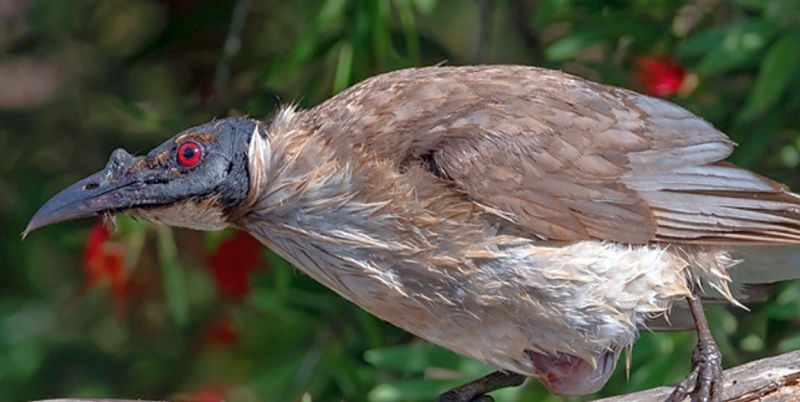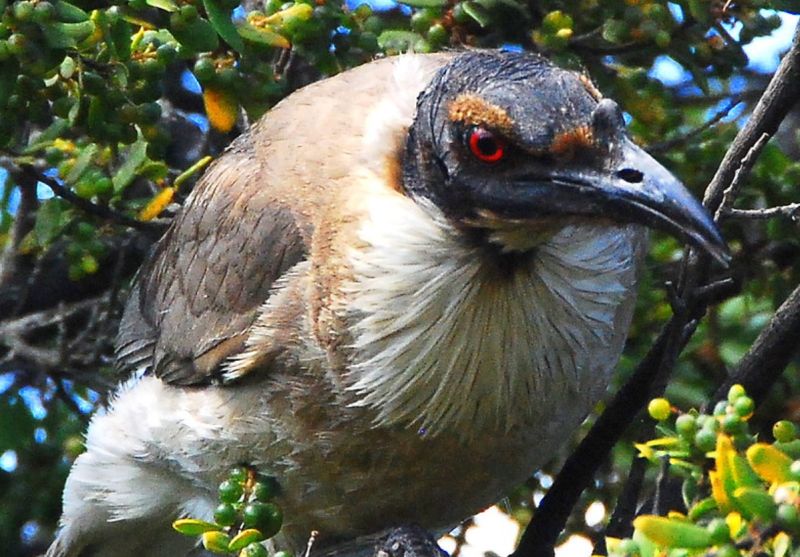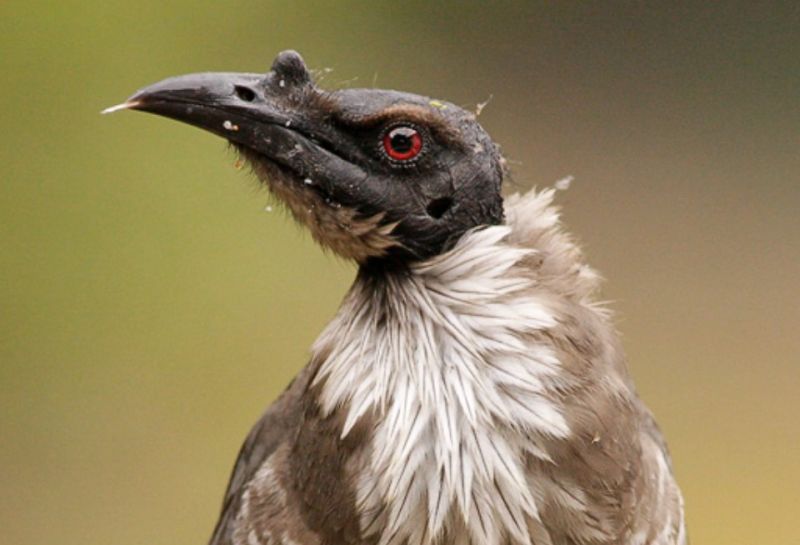Habitat: The noisy friarbird (Philemon corniculatus) the tonsured head of this big honeyeater, gives its name to having a bare head. All the other knob-billed friarbirds have partly feathered heads. Every spring and summer in southeastern Australia, the open eucalypt forests and woodlands ring with the day-long chuckling cackles and bubblings of this noisy bird.
It calls and sings perched with a bill thrown up to advertise feeding as well as breeding territory, and does so year-round in northeastern Queensland, where it is only locally nomadic. But south of 30°–35°S, it is migratory, shifting off mountain tops to low altitudes and traveling north as far as central eastern Queensland in March–April and returning in late August–September.
The birds move north in small, loose groups of up to 25–35, flying straight and high, often well over the tops of trees. On their return, they trickle south in one and twos through forest and woodland. Only the female may incubate, but both sexes attend to the young. Groups spread out to roost at night, with individual birds sleeping alone in tree crowns and signaling their position to one another at dusk and when waking at dawn with a repeated rolling ya-kob.
Pairs also break off to nest in territories of their own. In southern parts of eastern Australia, the species is migratory, moving north to overwinter and recurring south in the spring. Their noisy calls indicate an individual’s feeding territory and also announce the presence of food sources worth defending by other birds—not inevitably friarbirds alone.

Diet: Like other honeyeaters, Noisy Friarbirds are versatile feeders, taking nectar, insects, and even grapes, blackberries, and even syrup that oozes from sugar cane after it has been fired. It is often that the birds become a pest in stone-fruit orchards in late summer and are shot illegally. Flushes of flowers bring them to congregate in loose groups with other honeyeaters, particularly little friarbirds.
They are boisterously noisy and aggressive then, each bird defending its feeding branches, chasing off other competitors, and calling loudly in a cacophony. All feeding is arboreal, with the birds bouncing around in the branches, picking off fruit, gleaning under bark, along twigs, and among leaves for insects, and often hanging upside down on the outside of foliage as they probe flowers for nectar, from one to 30 meters above the ground. Flowering proteads and eucalypts provide most of their energy needs. Noisy Friarbirds also hawk for insects, fluttering up, catching prey in midair, then swooping back to the cover of foliage.

Identification: Both sexes are similar; however, the male is larger. The head and upper neck are of bare black skin, with a narrow line of gray-brown feathering over the eyes and a triangle of silver-grey feathering on the chin. Back, rump, and shoulders are mid-fawn-brown. The wings are mid-grey. The tail is mid-grey, square-ended, and has a narrow white tip. The lower throat and upper breast are ruffled with lanceolate, silvery-white feathers with dark shafts. The lower breast to the undertail is pale fawn.
The eyes are red. The bill is black, with a small black triangular knob at the base of the upper mandible. The feet are dusky gray. The immature bird’s neck and back of its head are molded gray and edged white on the shoulders, back, and sides of the neck. Flight feathers and tail are indistinctly edged green-yellow; flight feathers are tipped white. The throat and breast lack lanceolated feathers. The knob is not obvious, and the eye is brown.
Vocalizations: The noisy friarbird call is a rolling, double-note chant ya-kob or poor soldier as position calls; harsh, cackling tobacco, tobacco, and four o’clock at feeding sites; a loud brassy shout in pursuit. The song consists of rippling, chuckling cackles, often in duet or antiphonally between the sexes at set perches; the voice of the female is high-pitched. As its name suggests, it is a very noisy bird, and one of its calls has been likened to “four o’clock”. At such times, the continuous cackling and chattering of sounds can fill the forest. It is singing.
Nesting: Nesting and breeding occur in July–February. Nest is a large, deep, open cup of narrow strips of stringy bark at times interwoven with dry grasses, cobwebs, and pieces of cloth The nest is lined with fine grasses, wiry plant stems, and wool. The nest has built-in outer branches, camouflaged in thick foliage, 2–18 meters above ground, and occasionally in lower saplings. Moreover, these noisy birds are aggressively protective of their nests and are identified by swooping.
Eggs and Incubation: The noisy friarbird lay two or three, rarely five; light to dark pink-buff, vaguely spoiled and marbled with pale slate, chestnut, or violet-grey, particularly at the larger end; oval to tapered-oval, about 33 x 22 mm. Incubation is responsible for females.
Distribution: The noisy friarbird is found in coastal regions of the mainland from Cape York south to eastern Victoria (Lakes Entrance and the Murray Valley), in open areas in wet and dry sclerophyll forests, and in open woodlands. West of the range, it occurs in wooded areas along watercourses. It is also found in Papua New Guinea, mainly restricted to the Trans-Fly in the south of the island, where it is locally abundant.
Flight: When flying from tree to tree, they sometimes undulate and dive this way and that, their tail angled and twisted about; at other times, their flight is straight and direct.
Alternative Names: This bird is also known as Knobby-nose Leatherhead, Four o’clock Pimlico, Leatherhead, or Poor Soldier.
Size: The noisy friarbird is about 300 to 340 mm long.
Close Relatives: It is closely related to the silver-crowned friarbird within the genus Philemon.
Family: The noisy friarbird belongs to the honeyeater family Meliphagidae
Races: There are no races.







